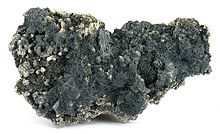Our website is made possible by displaying online advertisements to our visitors.
Please consider supporting us by disabling your ad blocker.
Boulangerite
| Boulangerite | |
|---|---|
 Boulangerite, covering a block of limestone | |
| General | |
| Category | Sulfosalt minerals |
| Formula (repeating unit) | Pb5Sb4S11 |
| IMA symbol | Bou[1] |
| Strunz classification | 2.HC.15 |
| Crystal system | Orthorhombic |
| Crystal class | Dipyramidal (mmm) H-M symbol: (2/m 2/m 2/m) |
| Space group | Pnam |
| Unit cell | 4,027.99 |
| Identification | |
| Cleavage | Good Distinct on {100} Indistinct on {001} and {010} |
| Fracture | Brittle |
| Tenacity | Brittle |
| Mohs scale hardness | 2.5–3 |
| Luster | Metallic |
| Streak | Reddish brown to black |
| Density | 5.9–6.2 |
| Pleochroism | Weak |
| Ultraviolet fluorescence | None |
| Melting point | Around 525 °C |
| Fusibility | Around 525 °C |
| Solubility | Completely soluble in hydrochloric acid Partially soluble in nitric acid |
| Common impurities | Cu, Zn, Sn, Fe |
Boulangerite or antimonbleiblende is an uncommon monoclinic orthorhombic sulfosalt mineral, lead antimony sulfide, formula Pb5Sb4S11.[2] It was named in 1837 in honor of French mining engineer Charles Boulanger (1810–1849),[3] and had been a valid species since pre-IMA. It was first described prior to 1959, and is now grandfathered.[4]
- ^ Warr, L.N. (2021). "IMA–CNMNC approved mineral symbols". Mineralogical Magazine. 85 (3): 291–320. Bibcode:2021MinM...85..291W. doi:10.1180/mgm.2021.43. S2CID 235729616.
- ^ Mineralienatlas
- ^ http://www.mindat.org/min-738.html Mindat
- ^ http://webmineral.com/data/Boulangerite.shtml Webmineral data
Previous Page Next Page


